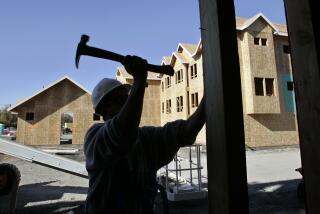Labor Data Send Mixed Signals on Inflation
- Share via
WASHINGTON — Growth in American workers’ productivity slowed to a lackluster pace in the April-June quarter, but labor costs remained contained, posing little threat of inflation.
Nonfarm business productivity--output per hour worked--grew at a seasonally adjusted annual rate of just 0.6% in the second quarter, the Labor Department said Tuesday. That is less than half the 1.4% annual rate of the first three months of the year and the worst showing since the third quarter of 1996, when productivity declined.
Gains in productivity help offset price increases for raw materials and are crucial for businesses to hold down the prices they charge.
“Competition is so stiff. Businesses have to become more efficient,” said Cynthia Latta, an economist at DRI/McGraw-Hill in Lexington, Mass. “It’s so hard to raise prices. Businesses have to get more out of labor.”
Though investors took comfort in the inflation news in the productivity report, Treasury bond yields rose and stock prices slumped as new statistics hinted at a rebound in chain store sales last week. The government will release reports today on producer prices and retail sales for July.
Most of the decline came in the afternoon, after LJR Redbook Research said department and discount store sales rose 0.3% last week and were 8.6% higher than for the same week a year earlier.
One reason for the jitters: The productivity decline in the second quarter calls into question one of the underlying supports cited by Federal Reserve Board Chairman Alan Greenspan in July for the reason the economy is performing so well.
An extended period of low inflation and continued growth could be “part of a once- or twice-in-a-century phenomenon that will carry productivity trends nationally and globally to a new higher track,” he said in congressional testimony. Greenspan hedged his bet, though, by saying he still needs convincing. “The recent improvement in productivity could be just transitory, an artifact of a temporary surge in demand and output growth,” he said.
Growth in hourly compensation also slowed markedly, from a 4.5% annual rate in the first quarter to a 3.1% rate in the second. That restrained labor costs per unit of output--a key component in price pressures. Those costs increased at a 2.4% annual rate in the second quarter, down from 3.1% in the first.
“Labor costs remain contained and do not pose an inflation threat to the economy,” said economist Cheryl R. Katz of Merrill Lynch in New York.
Rapid productivity gains supported the economic boom of the 1960s. But since the early ‘70s, productivity growth has averaged about 1% a year. It was 1.3% last year and 0.2% in 1995. However, many analysts aren’t particularly concerned about the recent figures because they believe actual productivity improvement is much better than the government reports indicate. They say the numbers aren’t picking up gains in many service industries that have been revolutionized by computers and advances in phone technology.
In another report released Tuesday, the National Assn. of Realtors said the value of most Americans’ homes rose faster than the rate of inflation over the past year, except in the Northeast.
Nationally, the median price of an existing home was $123,700 in the April-June quarter, up 3.9% from a year ago. The median rose 4.8 % in the West.
More to Read
Inside the business of entertainment
The Wide Shot brings you news, analysis and insights on everything from streaming wars to production — and what it all means for the future.
You may occasionally receive promotional content from the Los Angeles Times.










